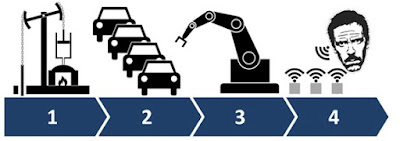Nowadays it is really easy that some kind of Anglicism or strange word generated abroad comes to our ears and, much to our regret, even without knowing its real meaning or what it refers to. This is very common, specially regarding people who are bound to the field of Information and Communications Technology (ICT from now on). Moreover, we should think in which society we are (also known as Information Society or Society of Communication. In other words, a society in which Internet and information exchange is part of our day by day). In fact, ICT is coming and invading almost every sector that composes the current society. This has happened, also, between ICT and manufacturing, giving the result of what is known as “Industry 4.0”, or what was formerly called “The Factory of the Future”.
From the union of these two aforementioned areas, more and more words that are difficult to understand and to manage have appeared, for example, fourth industrial revolution, cyber-physical systems or predictive models, among others. Therefore, dear reader, if you are one of those who overwhelms all this terminology and feels like a grandmother who asks his computer scientist grandson for his new job and does not understand anything, you have reached to the post you were expecting. A post that will try to make a definition of the Industry 4.0 suitable for all audiences.
Industry 4.0 is a process which is expected to build a “Digital Doctor” who is able to detect and to correct any disease of the production process, based on the symptoms that appear during this manufacturing process. This is carried out through a diagnosis, which consists of the following tasks:
– Observation. Every good doctor must find out what is happening based on the symptoms that are occurring and, also, based on the results of a series of tests that he determined necessary to obtain his goal. Of course, the doctor has a variety of tools and technologies to get the information he needs, for example, the use of X-ray or Computed Tomography (i.e., CT).
Thus, Industry 4.0, as the previous doctor, needs information on what happens and what the symptoms of the production process are. Thus, thanks to the incorporation of ICT, new devices are developed to evolve existing tools. These new devices, which are known as cyber-physical devices, have the ability to think, deduce and communicate information in a simple and digitized way using computer communication networks.
– Evaluation. Once all data has been collected, it is time to process, analyse and evaluate it, as our doctor does. In this moment, based on the symptoms reported by the patient and the observation of the process, together with the knowledge acquired by the doctor throughout his career; it is determined what the problem that affects to the patient is.
However, industry is not so simple. The volume of information generated within the process cannot be managed by people. Thus, it becomes to use ICT to find a way to perform this task. For this purpose, several techniques are used to combine all data received, detect repetitive situations that cannot be easily detected by the human eye, discover new information and classify the problem we are working on. All this is possible thanks to the work of hundreds of researchers that make today’s computers act as computers shown in movies. Although this may seem science fiction, it is carried out through large data processing computers, cloud computing and the employment of Artificial Intelligence.
– Decision making. Once the disease has been detected, the doctor tries to determine the treatment to be followed by the patient to get well. Likewise, in Industry 4.0, it should take appropriate decisions to solve the detected problem. Decision making can be carried out by people whom are presented the results obtained in previous tasks, by computers that apply the acquired knowledge and predictions based on the repetition of cases in order to determine the best path to follow; or by a collaborative work between humans and machines. The latter task will achieve the feedback that has to be transmitted to robots, equipment, machinery or operators of the production plant in order to manage the treatment for solving the detected problem; everything totally related with more cyber-physical devices.
Before saying goodbye, dear reader, I would like to explain to you that despite I have simplified Industry 4.0 until making it such as a Doctor House expert in manufacturing processes, note that you must be aware that it is not only that. Industry 4.0 intends to work on diseases that occur at different business levels: (i) production, (ii) management, (iii) logistics, (iv) quality and (v) environment, among others; but always working using the process explained above, a process of diagnosis based on observation, evaluation and decision-making.
Industry 4.0 is here to stay. Industry 4.0 has evolved the current way of performing the manufacturing process. Industry 4.0 is based on knowledge and whoever controls it, he will have the opportunity to advance. Industry 4.0 tries to evolve the current tools with the aim of generating much more powerful tools. But the Industry 4.0 can only be achieved in one way, building it ourselves.

Figure 1.-Industry evolution: (1) First revolution, steam machine; (2) Second Revolution, assembly line; (3) Third revolution, digitisation of processes; (4) Industry 4.0


